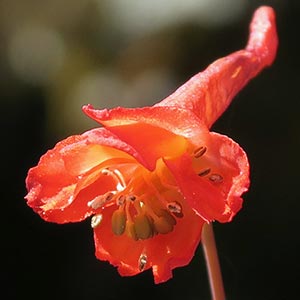Delphinium nudicaule
Delphinium polycladon
canyon delphinium, canyon larkspur, orange larkspur, red larkspur, red or orange larkspur, scarlet larkspur
high mountain larkspur, mountain marsh larkspur
(15-)20-50(-125) cm;
base reddish, glabrous.
(20-)60-100(-160) cm;
base reddish or not, glabrous.
blade round to pentagonal, 2-6 × 3-10 cm; ultimate lobes 3-12, width 5-40 mm (basal), 2-20 mm (cauline).
blade round to pentagonal, 1.5-7 × 2-14 cm, glabrous; ultimate lobes 3-12, width 4-30(-45) mm (basal), 3-30 mm (cauline).
5-20(-69)-flowered;
pedicel (1.5-)2-6(-8) cm, glabrous to glandular-pubescent;
bracteoles 14-20(-30) mm from flowers, green to red, linear, 2-4(-9) mm, glabrous to puberulent.
3-15(-35)-flowered, open, often ± secund;
pedicel 1-4(-15) cm, glabrous to puberulent;
bracteoles 2-8(-37) mm from flowers, green, linear, 4-7(-11) mm, nearly glabrous.
sepals scarlet to reddish orange, rarely dull yellow, glabrous, lateral sepals forward-pointing to form pseudotube, (6-)8-13(-16) × 3-6 mm, spurs straight, slightly ascending, (12-)18-27(-34) mm;
lower petal blades elevated, exposing stamens, 2-3 mm, clefts 0.5-1 mm;
hairs sparse, evenly dispersed, yellow.
sepals bluish purple, nearly glabrous, lateral sepals spreading, (10-)12-18 × 7-10 mm, spurs usually downcurved, ca. 30° below horizontal, 11-22 mm;
lower petal blades slightly elevated, ± exposing stamens, 4-6 mm, clefts 1-2 mm;
hairs mostly near base of cleft on inner lobes, yellow, sometimes white.
13-26 mm, 3.5-4.5 times longer than wide, glabrous.
13-20 mm, 3.5-4 times longer than wide, puberulent.
unwinged or sometimes slightly wing-margined;
seed coat cells with surfaces smooth.
unwinged;
seed coat cells with surfaces roughened.
= 16.
= 16.
Delphinium nudicaule
Delphinium polycladon
Delphinium nudicaule hybridizes with most other taxa of Delphinium that it encounters. Apparent hybrids involving D. nudicaule, and seen by the author (either afield or as specimens), include D. andersonii, D. antoninum, D. decorum, D. luteum, D. nuttallianum, D. patens, and D. trolliifolium. In addition, garden-grown plants have been hybridized with D. cardinale, D. elatum, D. menziesii, D. parishii, D. penardii, D. tatsienense Franchet, D. triste Fischer ex de Candolle, and D. uliginosum; D. nudicaule does not naturally occur with these species. Delphinium nudicaule is one of the earliest larkspurs to flower in any given locality. Douglas's type collection of D. nudicaule represents plants (synonyms D. sarcophyllum Hooker & Arnott and D. peltatum Hooker, an invalid name) grown under very moist conditions, probably quite near the ocean. The type specimen of D. armeniacum A. Heller represents plants grown under unusually dry conditions.
The Mendocino Indians consider Delphinium nudicaule a narcotic (D. E. Moerman 1986).
(Discussion copyrighted by Flora of North America; reprinted with permission.)
Delphinium polycladon hybridizes with D. depauperatum and D. glaucum. Plants of D. polycladon are extremely variable. Individuals from very rocky, thin-soiled, sunny sites at higher elevations tend to be quite compact; they show the features of the species in a dwarfed state. Proximal internodes are especially shortened. Plants from areas of deeper soil (high or low elevations), especially those growing among shrubs, usually are much taller, with elongate proximal internodes, and other vegetative parts proportionally larger. Shorter plants may be confused with D. depauperatum or D. nuttallianum; see discussion under those species for distinguishing features. Taller plants may be confused with D. glaucum; they can be distinguished by their leaves predominately on proximal part of stem, sigmoid pedicel, and fewer flowers.
(Discussion copyrighted by Flora of North America; reprinted with permission.)


